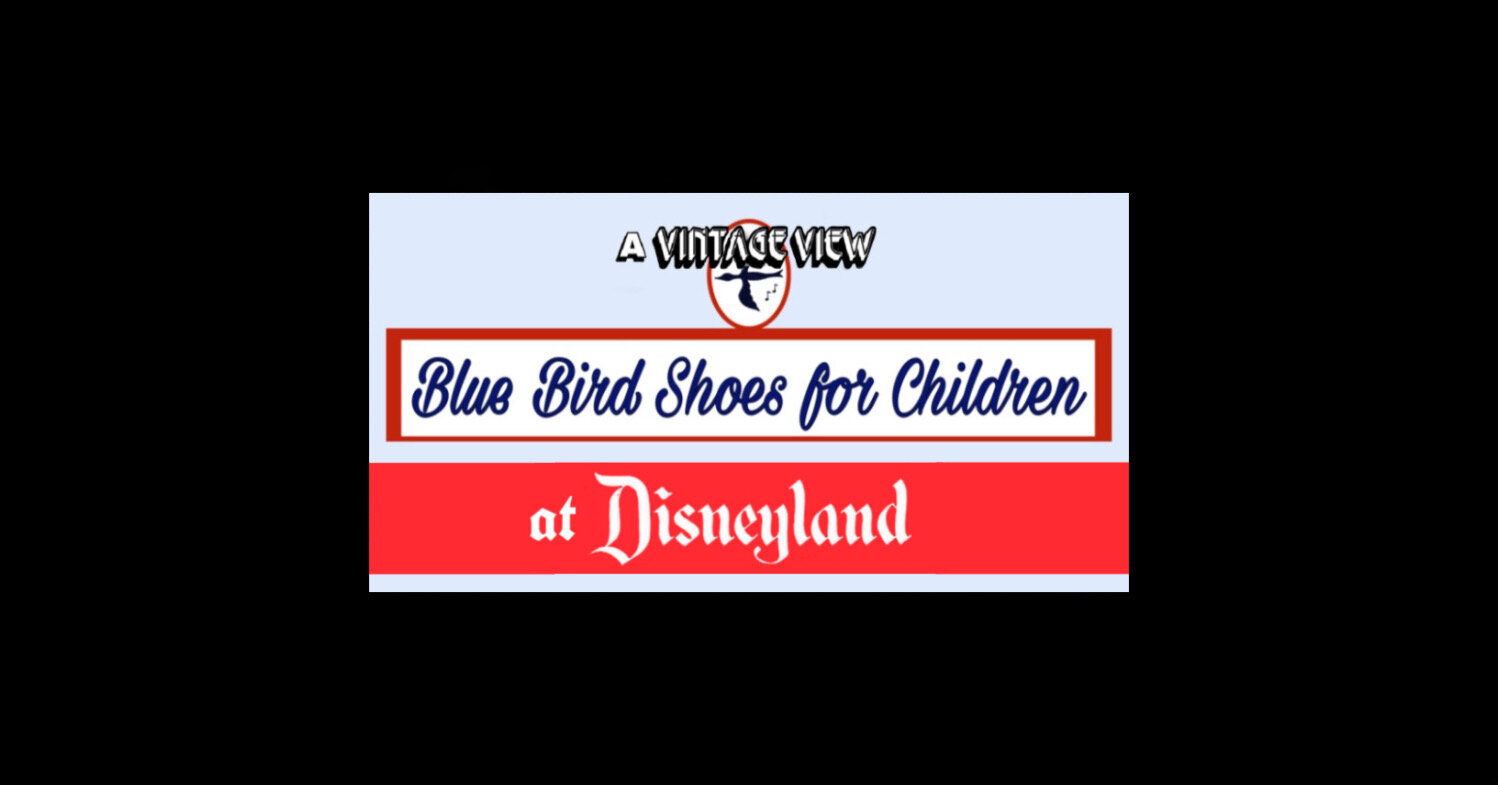BLUE BIRD SHOES FOR CHILDREN (Gallen-Kamp)
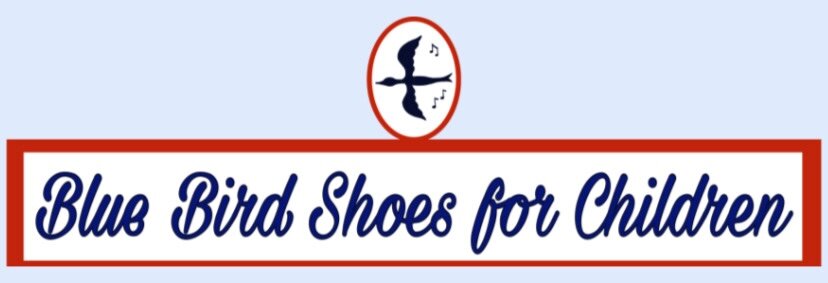
(1955 - September 13, 1957)
Since the 1930s, the Walt Disney license has been extended to shoe manufacturers.
“The Search for Participant Sponsors of Disneyland”
During 1954, Walt was searching for participants to lease shop and restaurant spaces at DISNEYLAND®, and help generate the necessary capital to fund the construction of Disneyland. In a synergistic relationship, the companies (in turn) could sell their products and advertise their corporate names in the Park. Disneyland Participant Corporate Sponsors were carefully selected. High quality, long term corporate sponsors would provide incremental income that enabled Disneyland to enhance its show and attractions, offset some operating expenses, and capitalize on marketing opportunities.
By July 1, 1954, Russel Tippett of Advertising oversaw Exhibitor’s Space Sales and Lease Agreements. Individuals like Nat Wyncoff provided the essential orientation for curious lessees, selling them on the idea of Disneyland using various visual aids like sketches and one of Herb Ryman’s oil paintings of Disneyland. Soon, “A cross-section of American industry…[was to be] represented in Disneyland. Each of these companies… [would expose] its institutional advertising and public relations message to Disneyland guests through various forms of participating exhibits and displays. In each case, the exhibit… [was to be] related to the theme of the ‘land’ in which it is located, and is woven into the overall concepts and themes of Disneyland,” according to “Disneyland, U.S.A.,” published 1958. As Walt described to Bob Thomas (of Associated Press), “some industries will have exhibits, but all of them must be in keeping with the era.” As intended, many of the free exhibits located on Main Street U.S.A. came to be sponsored by one of the United States’ “old reliable firms, which have been in business fifty years or more. Here they can show how they started and reproduce their first place of business,” [according to one draft of the Disneyland Prospectus, published 1954].
Several of those “old firms” (which leased spaces) specialized in apparel for men, women and children! The Hollywood- Maxwell Intimate Apparel Shop (a fairly “young” firm), presented by the Hollywood-Maxwell Brassiere Co. of Los Angeles, afforded guests the opportunity to view “early day corsets and foundation garments.” Another shop (located North of Coca Cola Refreshment Corner) originally housed merchandise offered through the swimwear manufacturer and retailer Cole of California. Fantasy of Disneyland also carried clothing - like a large selection of designer little cardigan sweaters, party dresses, “Hollywood Knits,” and jumpers (by vendors like Johnny Lee of California, or Nob Hill of California). These were just a few of the shops that were located inside Disneyland, and there were many others that came to be located at the Disneyland Hotel! Yes, “shopping has been a part of the Disneyland scene since opening day, 1955, when just 45 employees worked in the Park’s five stores and stands,” according to Disney News (Fall, 1966). The same publication called Walt Disney’s “Magic Kingdom actually… like a huge specialty shopping center, with thirty Disney-operated stores catering to every taste and purse. In addition, some of America’s most famous ‘name brand’ merchandise is sold in the stores of Park lessees.” Soon (possibly owing to Harry Karl of Karl’s Shoes and Shoe Corp.) the GallenKamp Stores Company would become a Disneyland Participant sponsor and open their doors at 208 Main Street!
“Architectural Designs by Lessees”
Disneyland, Inc. printed materials for Lessees detailing specifications for architectural designs of exhibit spaces. These were revised by March 16, 1955 and issued to Lessees.
All of the interior architectural drawings were done by competent registered architects or an approved display house of the lessee's choice. All of the designs submitted by the lessee's architect, whether for buildings or construction of interiors in DISNEYLAND, were approved as to the theme and general plan of DISNEYLAND as established by WED Enterprises, Inc.
Three sets of preliminary drawings were furnished DISNEYLAND, Inc. as soon as possible after signing of the lease. Two sets were retained by DISNEYLAND and one set was returned to the lessee’s architect with any revisions noted thereon and stamped “APPROVAL TO PROCEED TO FINAL DESIGN.” This stamp when properly signed and dated constituted the lessee’s authority to proceed with the final drawings.
The Lessees revised their final drawings to incorporate any revisions noted on the approved preliminary drawings, and submitted three sets of the revised drawings to DISNEYLAND. One set was returned to the lessee’s architect and any revisions noted thereon are to be incorporated on the original drawings. When the lessee had incorporated the final revisions on the drawings, two sets of transparent ozalids were forwarded to DISNEYLAND for approval. DISNEYLAND would stamp both sets “FINAL DESIGN APPROVED” and “LESSEE’S CONTRACT DRAWINGS”, and return one set to the lessee who could then release drawings for bid and/or construction.
“Construction”
“Disneyland is unique in that some of the world's foremost creative artists and architects control all design at Disneyland.“ F. M. Franz, manager of operations for McNeil Construction expressed: "We feel sure there has never been anything built like this in Southern California, or elsewhere in the United States. Many of the items were constructed from artist’s sketches.”
Forced perspective would make the buildings on Main Street appear taller than actually are. On Main Street the buildings would not be full scale. Ground floors were built about 9/10ths scale. Second floors measured up to 7/10ths scale. The scale on the uppermost floors would be smaller still.
First, a concrete foundation and slab floors were prepared, followed by wood frame construction (while store units would have a combination wood and rigid steel frame).
According to inserts published in area newspapers during July of 1955, Disney buildings were roofed by Pioneer Roof & Shingle Company (then located at 608 Mateo Street, Los Angeles, California; 7522 Westminster Avenue, Westminster, California). The roof covering was a variable, dependent on the architectural design.
As of June 2, 1955, C.V. Wood Jr. sent an Inter-Office Memorandum to Walt Disney regarding the best estimates that could be obtained at the time regarding the completion status of individual sections of the Park and Opening Day. C.V. wrote: “Building #510 - Blue Bird Shoes: This one is doubtful. However if we do not make it, it will be an easy one to block off and dress.”
By July 2, 1955, shadow gags were ordered. Painted signs, window, curtains, and shades were projected to be completed on time. The sound equipment was be installed, with completion of the tape recordings appearing to be fairly tight. The electric signs were “in work,” and with the exception of the shoe store and the Bank of America, all were to be completed.
The buildings (as each on Main Street U.S.A.) possessed complete fire sprinkling systems. By June 30, 1955, related Disneyland Site Work Fire Protection Utilities Plot Plans were prepared for Disneyland Inc., by J.E. Thomasson of WED Enterprises Inc.

Blue Bird Shoes for Children Architectural Facade (or, Front of House) on Main Street
"Ev'ryone Would Own a Dozen Blue-Birds"
As Van Arsdale France (founder of the University of Disneyland) explained in a presentation for potential Disneyland Participant sponsors in May of 1955: These top executives of major American corporations were “here not to make money” but because they were to “create happiness!” This is evident by the income received by Disneyland, Inc. due to the corporate Participant sponsors and lessees. For example, three years later (in 1958), Bank of America appraisers figured of the total income received from leases, 16.02% was derived from the selling of advertising rights and 40.12% from the leasing of space to concerns whose main reason for occupancy is for advertising purposes. The remaining 43.86% of the lease income was derived from stores that sell various products and food.
A contributing writer of The Daily Oklahoman (who visited on July 17, 1955) noted: “The guests walked into a city square of the 1900 era, bounded by an old time railroad station, city hall and fire station, opera house and other vintage merchant houses.” Two days prior (and before Disneyland opened), an article published in Pacific Coast Review (published July 15, 1955), briefly and ambiguously mentioned that “Other names in this advertisers wonderland include Gallen Kamp shoes.”
Clearly the Participant sponsors and lessees were here to create happiness. Gallen-Kamp had recently won commendation by Parent’s magazine, and so parents may have been happy to discover that this particular Disneyland specialty shop offered a wide selection of their “all leather” children’s footwear. Among the c. 1955 stock was undoubtedly the “Gallen Kamp’s Saddle” (retailing $4.99), which was advertised as a “school shoe.” These were offered in all-black, all-white, as well as a variety of two-toned color schemes (including brown & white, blue & white, red & white, green & white, pink & black, pastel pink & white, and pastel blue & white). Another popular model (for girls) was the Patent Leather Strap, which can be seen in this c. 1955 advertisement below.
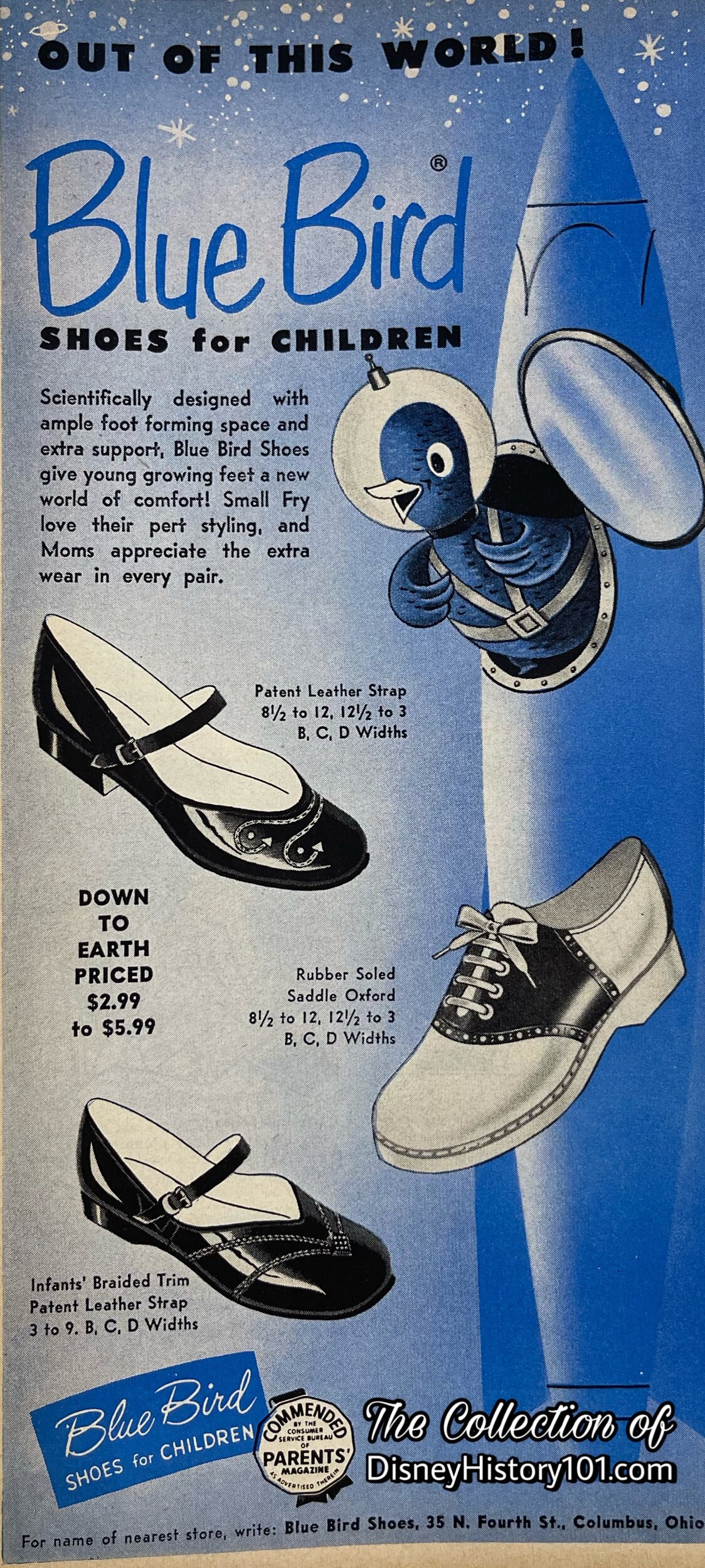
Blue Bird Shoes for Children Advertisement Featuring Shoe Models, c. 1955
Like many Main Street exhibits, complimentary souvenirs were offered - maps of Disneyland. The souvenirs of Blue Bird Shoes for Children featured these Gallen-Kamp advertisements on one side.
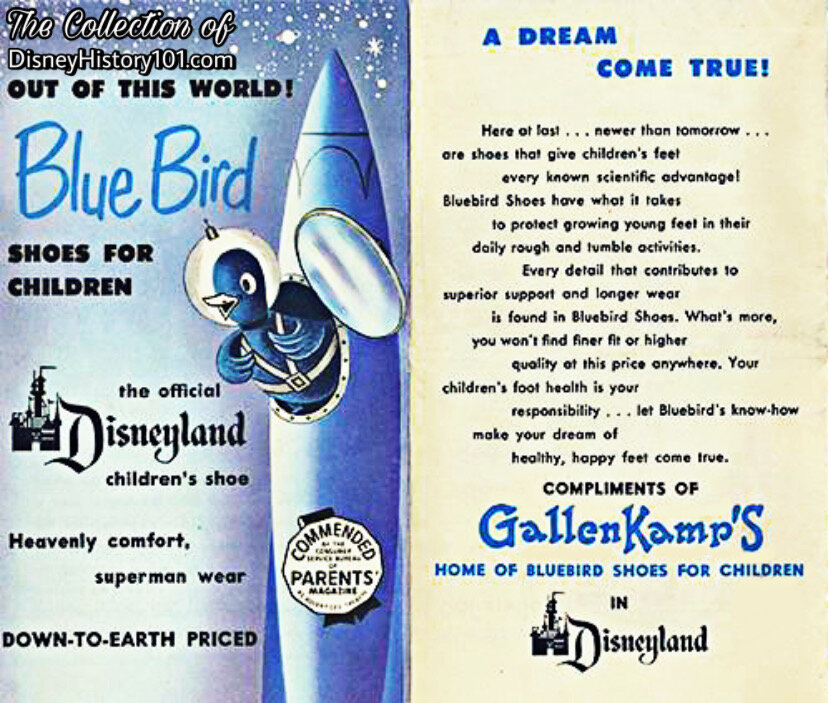
Blue Bird Shoes for Children Souvenir Excerpt, (1955)
Some of the first window displays were created for the winter of 1955 when Main Street windows carried out Nursery Rhyme themes. The Shoe Store window showed “The Old Woman Who Lived in a Shoe.”
According to The Disneyland Shopper (published 1955): “Half the fun of buying Christmas Gifts is the atmosphere you shop in. You couldn't ask for more in the way of the spirit of Christmas than to shop in Disneyland. Especially along Main Street will you catch the air of the good old-fashioned Christmas with wreaths of holly, Christmas bells, carolers, snow-frosted windows gaily decorated with fairytale rhymes, and the scent of pine boughs in the air. Ringing through this Magic Kingdom are the Christmas Songs we all love to hear.”
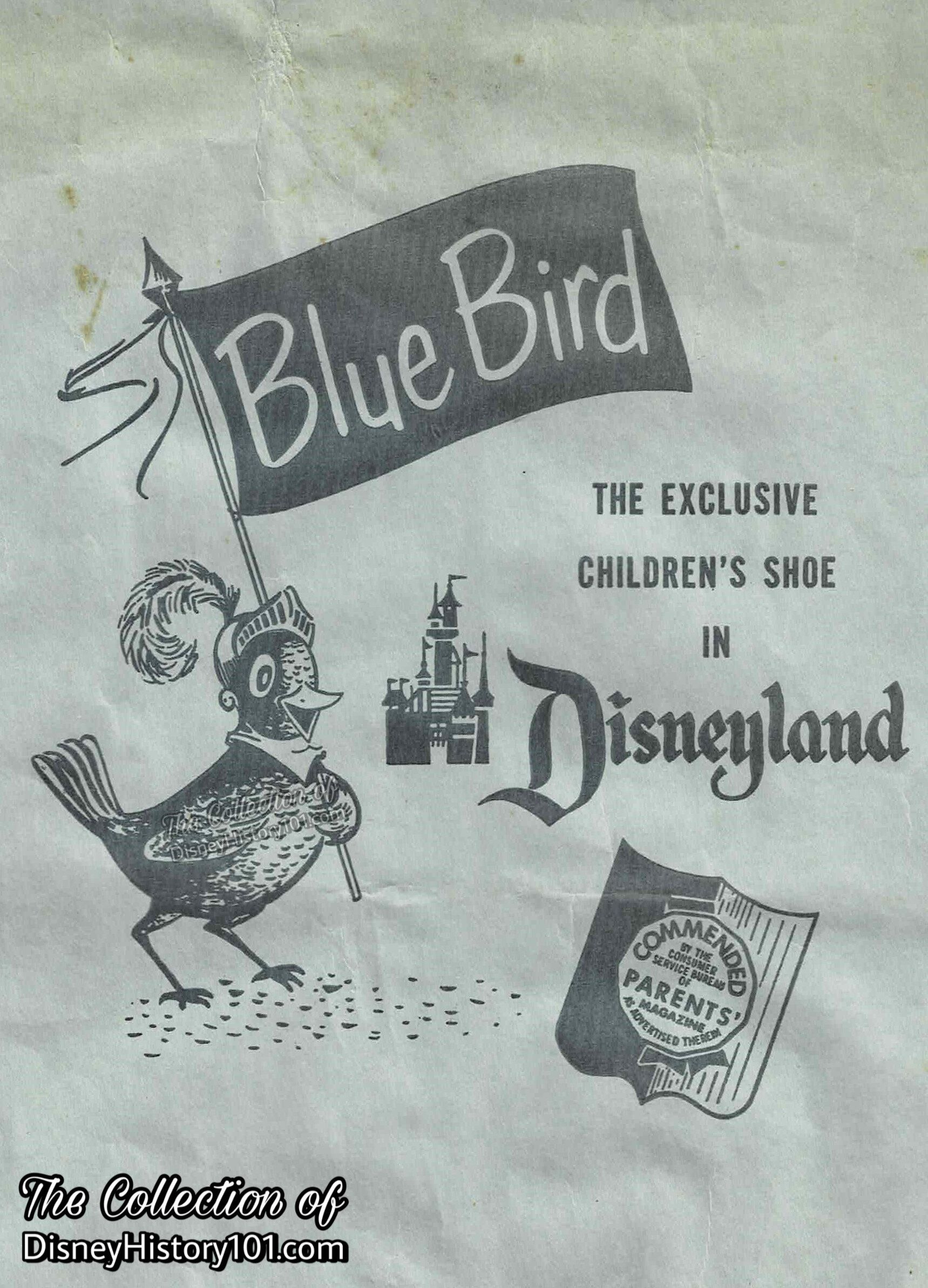
Blue Bird Bag Graphic Excerpt, (The Collection of Disney History 101)
The “Disneyland 1st Anniversary Souvenir Pictorial,” encouraged visitors to “browse through stores whose shelves bulge with worlds of distinctive merchandise.” From the Swift’s Market House to the Tomorrowland Art Corner, Disneyland shops of the first fabulous decade often offered shipping for merchandise, and Gallen-Kamp merchandise could also be shipped to another address for guest’s convenience.
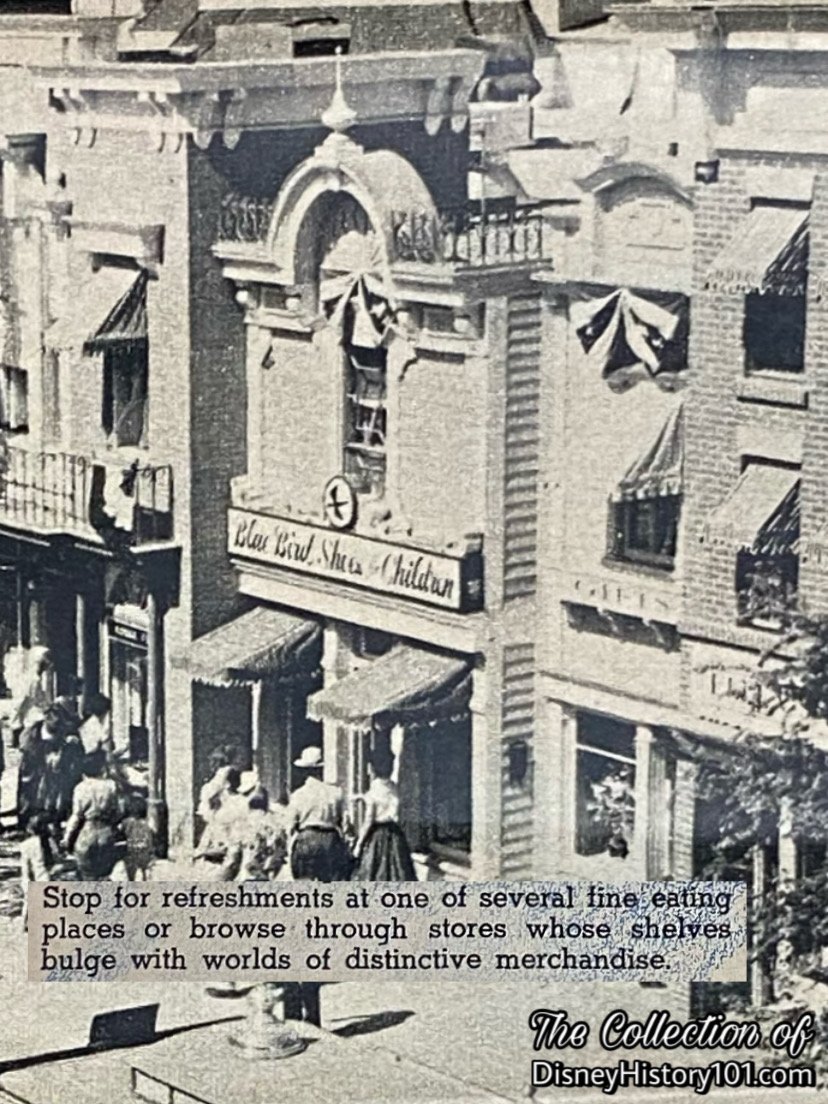
Blue Bird Shoes for Children as seen in Excerpts from “Disneyland 1st Anniversary Souvenir Pictorial”
Disneyland celebrated its first year of operation with the “Disneyland 1st Anniversary Souvenir Periodical” in 1956. While many Disneyland Participants and Lessees that hosted “show exhibit demonstrations” were spotlighted in a special section, those who leased space for shops were not. However, Blue Bird Shoes for Children is prominently seen in one large photograph of Main Street featured on the second page (pictured above).
Soon the 1957 TWA brochure “Let’s Talk About… My Visit to Disneyland, Anaheim, California: A Note from Mary Gordon TWA Travel Advisor” mentioned: “We learned that to fully explore Disneyland takes two days, so early next morning we were at the gates of the park again. The second day we spent more time shopping in the 50 inviting shops, and the youngsters bought inexpensive souvenirs to take home to friends.”
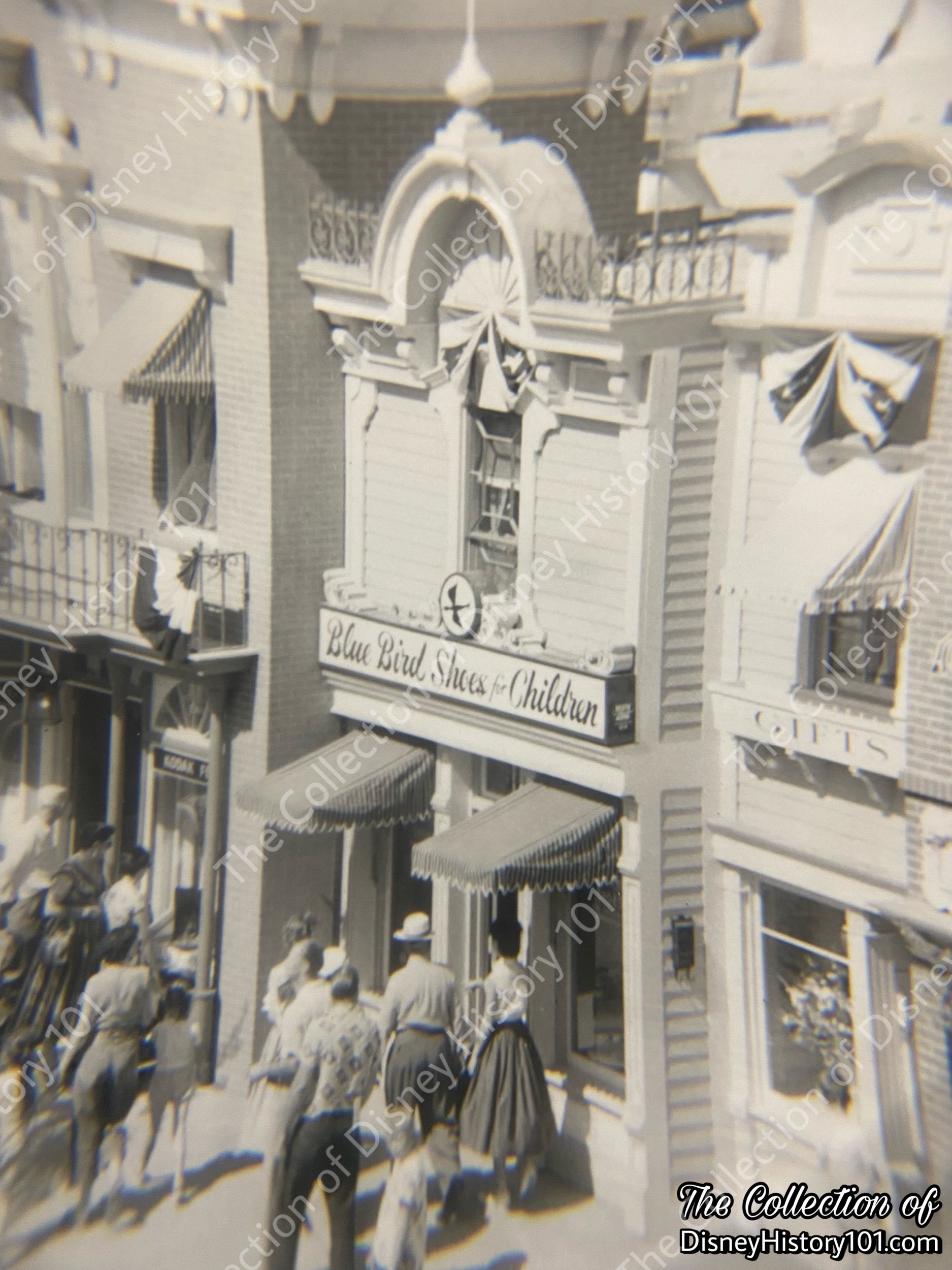
A print of the original photo that was published in the “Disneyland 1st Anniversary Souvenir Pictorial”
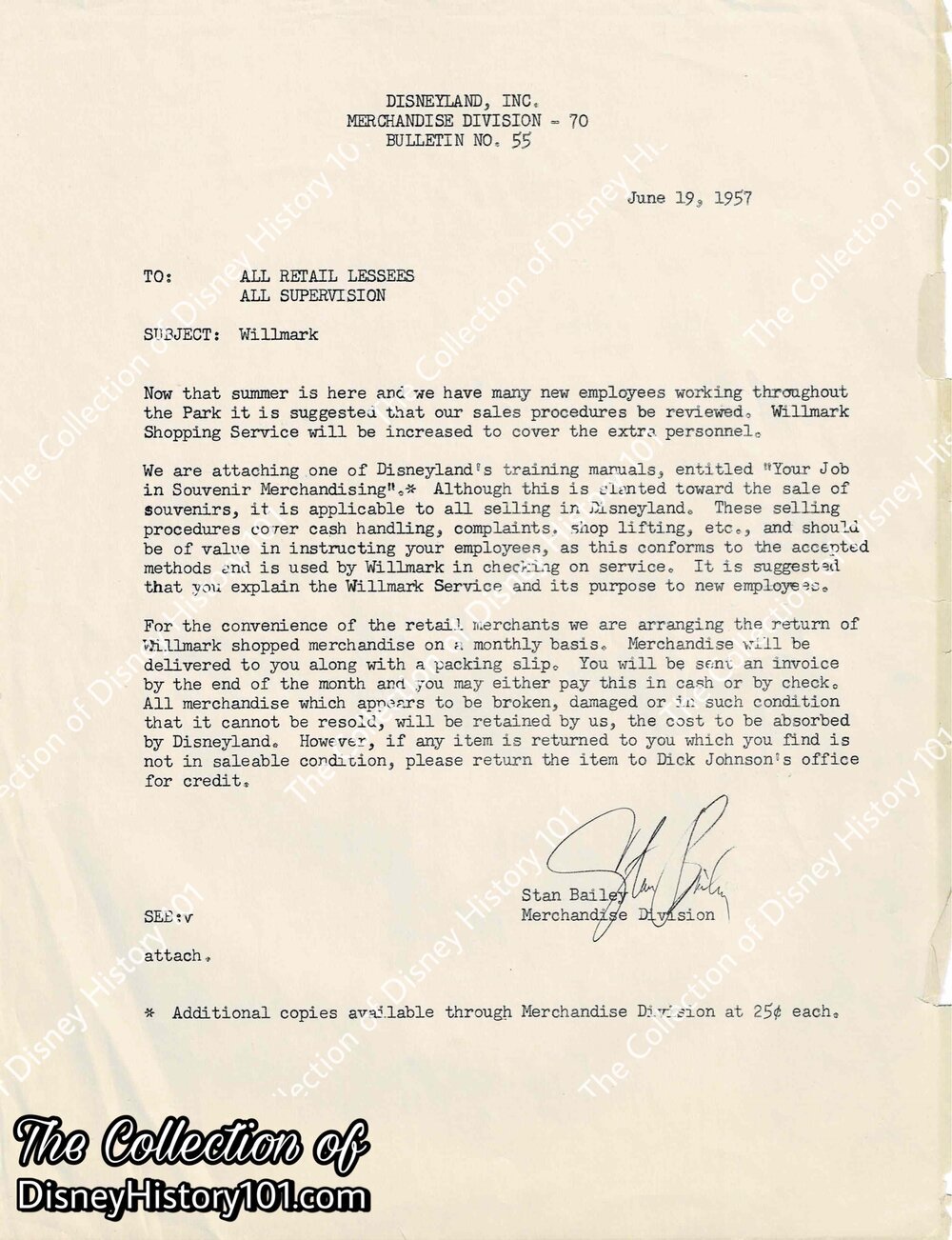
Before Bluebird departed, Disneyland, Inc. utilized the Wilmark Shopping Service to assure higher levels of quality service in Souvenir Merchandising.
Many parents (and many children) enjoyed the thrill of purchasing shoes at Disneyland. Blue Bird Shoes for Children created tangible memories Guests through its merchandise and show. And so, Blue Bird Shoes for Children would last the longest among a first wave of apparel-related lessees to depart from Disneyland, joining the ranks of “Grandma’s Babies Infant’s Clothes & Knitwear” Shop (July, 1955 - September, 1955), the Hollywood-Maxwell Intimate Apparel Shop (July, 1955 - January, 1956), and Cole of California (1955 - 1957). While other Gallen-Kamp locations would continue to offer those “fine leather shoes,” this particular Blue Bird Shoes for Children location would close its doors on September 13, 1957.
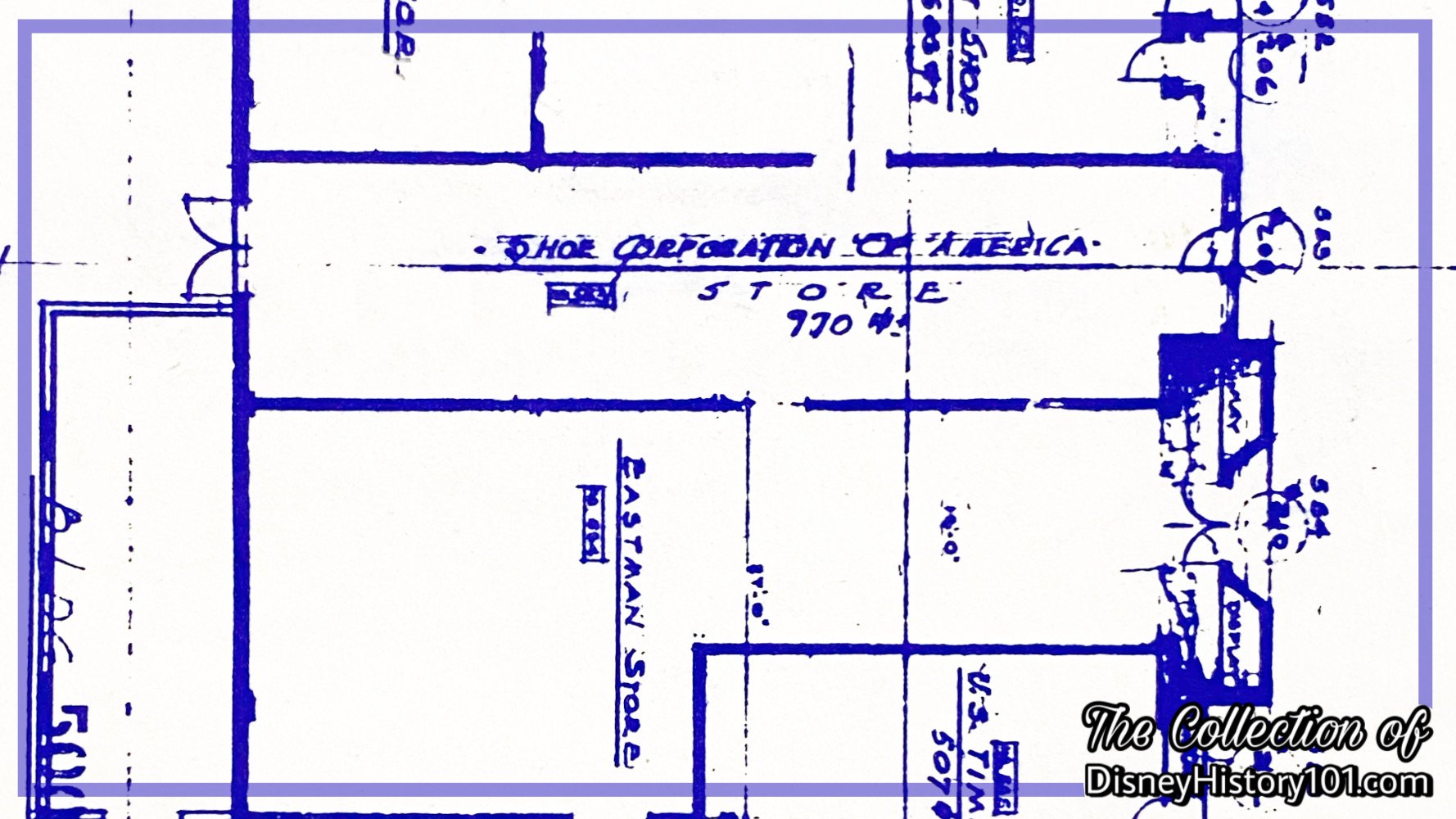
Shoe Corporation of America on the Key Plan for Main Street Units 300-400 & 500-600 by Disneyland, Inc.
“Where Is That Bluebird?”
The location which Bluebird Shoes for Children occupied was swiftly replaced by Wonderland Music Company (until c.1959), and then consumed by Kodak Camera Center.

